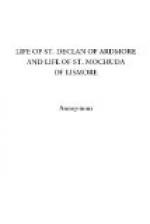The Rule of St. Carthach is one of the few ancient Irish so-called monastic Rules surviving. It is in reality less a “rule,” as the latter is now understood, than a series of Christian and religious counsels drawn up by a spiritual master for his disciples. It must not be understood from this that each religious house did not have it formal regulations. The latter however seem to have depended largely upon the abbot’s spirit, will or discretion. The existing “Rules” abound in allusions to forgotten practices and customs and, to add to their obscurity, their language is very difficult—sometimes, like the language of the Brehon Laws, unintelligible. The rule ascribed to Mochuda is certainly a document of great antiquity and may well have emanated from the seventh century and from the author whose name it bears. The tradition of Lismore and indeed of the Irish Church is constant in attributing it to him. Copies of the Rule are found in numerous MSS. but many of them are worthless owing to the incompetence of the scribes to whom the difficult Irish of the text was unintelligible. The text in the Leabhar Breac has been made the basis of his edition of the Rule by Mac Eaglaise, a writer in the ’Irish Ecclesiastical Record’ (1910). Mac Eaglaise’s edition, though it is not all that could be desired, is far the most satisfactory which has yet appeared. Previous editions of the Rule or part of it comprise one by Dr. Reeves in his tract on the Culdees, one by Kuno Meyer in the ’Gaelic Journal’ (Vol. V.) and another in ‘Archiv fuer C.L.’ (3 Bund. 1905), and another again in ‘Eriu’ (Vol. 2, p. 172), besides a free translation of the whole rule by O’Curry in the ‘I. R. Record’ for 1864. The text of the ‘Record’ edition of 1910 is from Leabhar Breac collated with other MSS. The order in the various copies is not the same and some copies contain material which is wanting in others. The “Rule” commences with the Ten Commandments, then it enumerates the obligations respectively of bishops, abbots, priests, monks, and culdees [anchorites]. Finally there is a section on the order of meals and on the refectory and another on the obligations of a king. The following excerpt on the duties of an abbot (’I. E. Record’ translation) will illustrate the style and spirit of the Rule:




